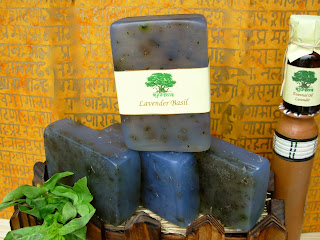By a fortunate coincidence, Saffron, an exotic spice that tops my list, was also favoured by Mirabai, my favourite poet saint. Mirabai is best known for her passionate devotion to Lord Krishna.
The saffron of virtue and contentment
Is dissolved in the water-gun of love and affection.
Pink and red clouds of emotion are flying about,
Limitless colours raining down.
All the covers of the earthen vessel of my body are wide open;
I have thrown away all shame before the world. Mira's Lord is the Mountain-Holder, the suave lover.
I sacrifice myself in devotion to His lotus feet.
Getting back to the spice, it is derived from the flower of saffron crocus (Crocus sativus), a member of the Iris family. Saffron is the stigma, or female part, of an autumn-flowering purple crocus. When the crocus blooms in late October, for a period of only two weeks, the plantations resemble carpets of lavender. Workers must harvest the flowers early in the morning, while they are closed, and remove the stigmas one by one, by hand. This painstaking process simply can’t be mechanized, which partly explains the high cost. It takes 200,000 flowers to yield a kilo of Saffron!
Saffron is mentioned in the oldest Ayurvedic treatises like Charaka Samhita & Sushruta Samhita. Most saffron is grown in a belt of land ranging from the Mediterranean in the west to Kashmir in the east. Some of the best saffron in the world comes from Kashmir where it has been grown in the fields of Pampore near Srinagar for close to 2000 years. It has been used medicinally to reduce fevers, cramps and enlarged livers, and to calm nerves.
Saffron is widely used in Iranian (Persian), Arab, Central Asian, European, Pakistani, Indian, and Turkish cuisines. Its aroma is often described as reminiscent of metallic honey with grassy or hay-like notes, while its taste has also been noted as hay-like and sweet. In texts of Ayurveda the herb Crocus Sativus or kumkuma or saffron is grouped under ‘Varnya’ gana. Varnya means the one which imparts fairness and glow to skin. You too can enjoy the beauty benefits of Saffron at home by making a paste of sandal wood and saffron. Dilute this with little water and apply it as face pack. This helps to reduce acne, pimples, dark circles, dark pigments and brings a glow to your skin.
AyurSens’ Almond Milk and Saffron is a truly royal bathing bar, enriched with the milk of Almonds and Kashmiri Saffron to moisturize and nourish delicate skin. Saffron is therapeutic and unleashes its calming effect in combination with Almond milk. http://www.ayursens.com/almond_milk.html
AyurSens’ Royal Saffron is an exquisite bathing bar enriched with the goodness of exotic Kashmiri saffron, the most precious spice in the world. Pamper your skin with a golden glow and an enchanting aroma that lingers all day long. http://www.ayursens.com/royal_saffron.html
 Based on an ancient Ayurvedic recipe, AyurSens’ Sandal Saffron is endowed with an exciting blend of exotic Sandal and Kashmiri Saffron. Sandal and Saffron complement each other to enhance your complexion, promote glowing skin and increase your skin’s resistance to bacteria and sunburns. This classic blend combines the subtle aroma of Saffron with the evocative fragrance of Sandal. http://www.ayursens.com/sandal_saffron.html
Based on an ancient Ayurvedic recipe, AyurSens’ Sandal Saffron is endowed with an exciting blend of exotic Sandal and Kashmiri Saffron. Sandal and Saffron complement each other to enhance your complexion, promote glowing skin and increase your skin’s resistance to bacteria and sunburns. This classic blend combines the subtle aroma of Saffron with the evocative fragrance of Sandal. http://www.ayursens.com/sandal_saffron.html
I want to end this article with a note of support for the people of Kashmir. For two weeks every year, thousands of people in the troubled state of Indian Kashmir stop their daily lives and head for the fields to start the region's famous saffron harvest. In the last 20 years, this farming was hit hard by conflict between armed separatist groups and the Indian army. But a decline in militancy in the area means farmers now believe their businesses will finally get a chance to flourish.
Normal life comes to a halt as families work painstakingly together to strip the saffron flowers. Kashmir has produced saffron for more than 1,000 years. Even when the militant insurgency was at its height there a few years ago, people still flocked to the fields for the annual harvest. Despite the fact that their crop commands a high price, almost $1000 for a kilo of this spice, they are struggling to produce enough to meet the massive demands of the Indian market.
I pray for the success and happiness of our Saffron farmers, many of whom I have come to know personally. AyurSens will always support purity and will never buy or trade in spurious quality or adulterated spices.
Finally, I urge you to take the time to look after ‘you’ and rediscover your inner glow naturally!
















